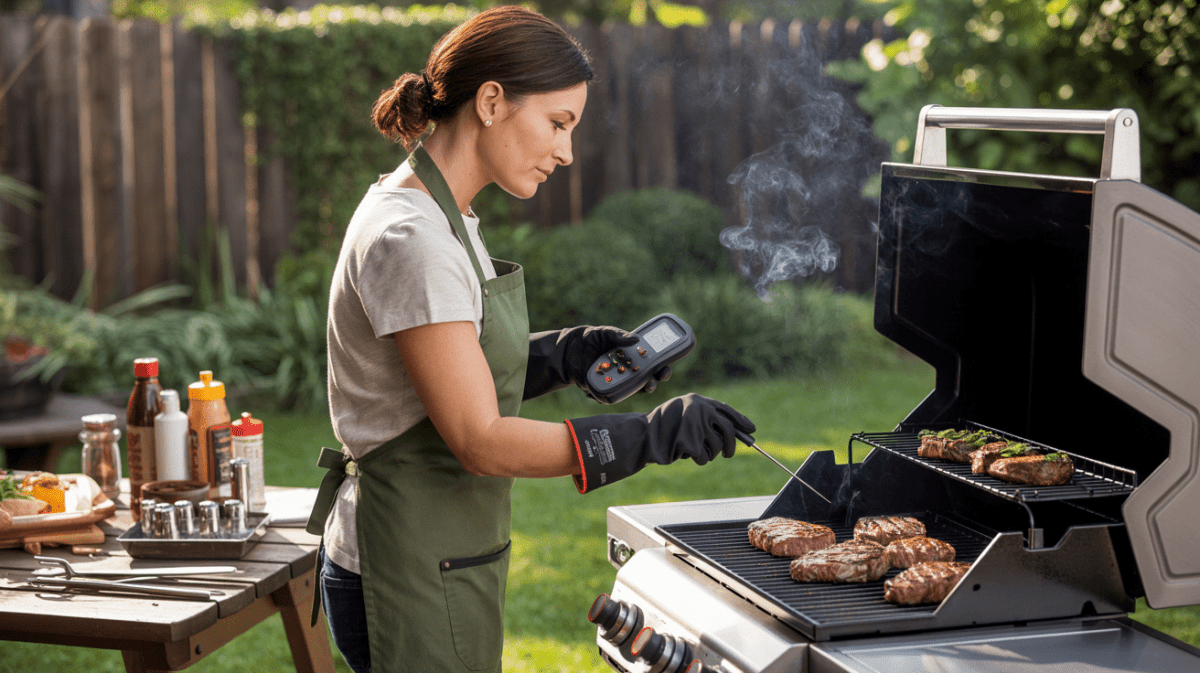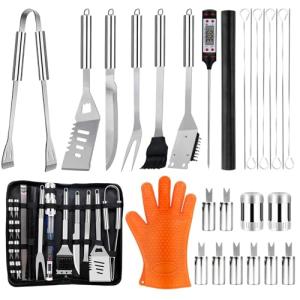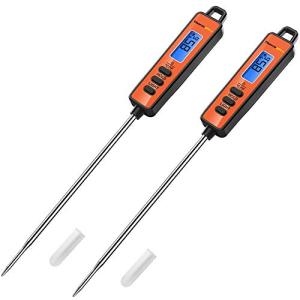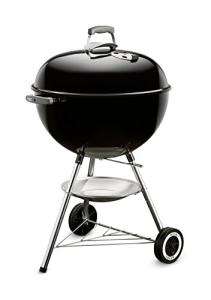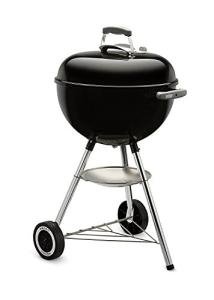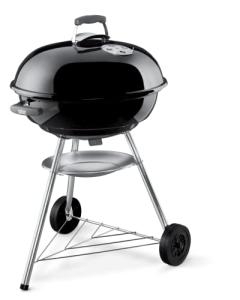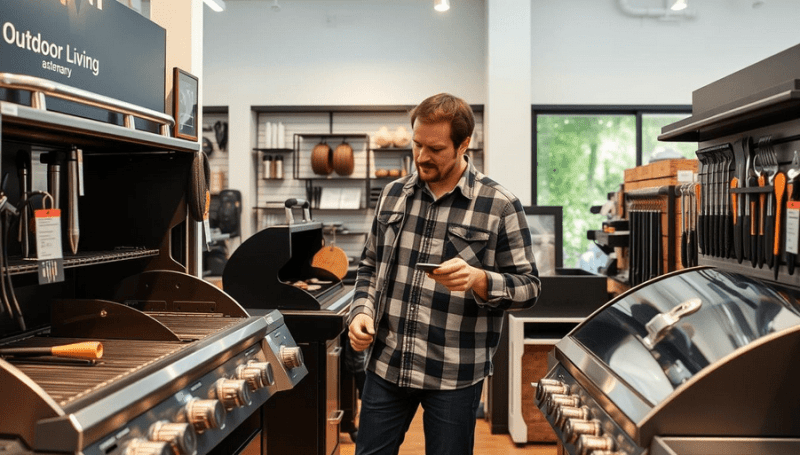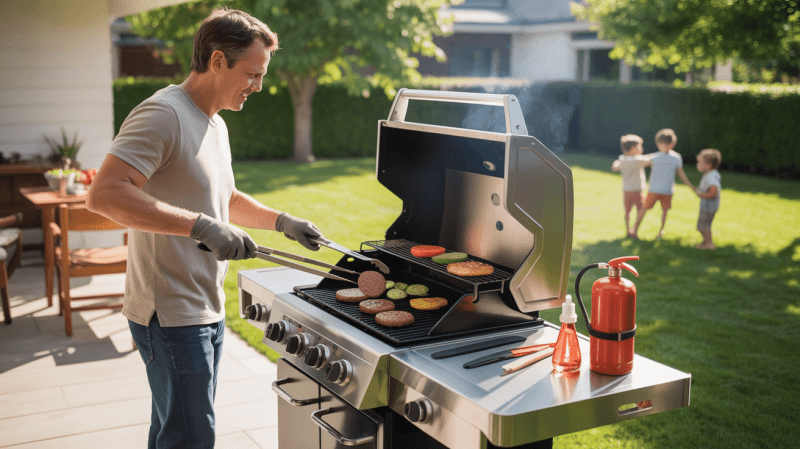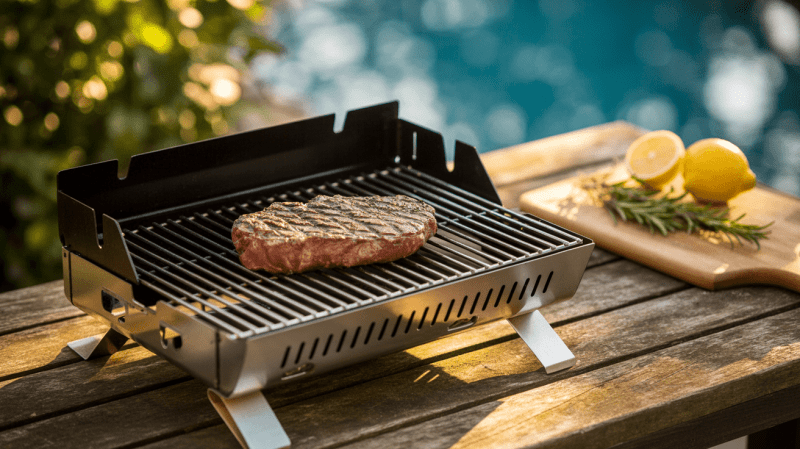Grill Thermometers: Do You Really Need One?

Ever cut into a beautiful steak only to find it's raw in the middle? I've been there too many times. Guessing when your meat is done can lead to disappointment at the dinner table.
After testing dozens of tools over the years, I learned something crucial. A good thermometer takes the guesswork out of grilling. It ensures everything cooks perfectly every single time.
This guide will show you exactly why this tool is a game-changer. Whether you're new to cooking outdoors or a seasoned pro, you'll find valuable insights here.
Say goodbye to dry chicken and undercooked burgers. Let's dive into how the right device can save you time, money, and frustration.
Key Takeaways
- Using a thermometer guarantees your food is cooked to the perfect temperature.
- It eliminates guesswork and prevents both undercooked and overcooked meals.
- This tool is essential for achieving consistent, restaurant-quality results at home.
- It helps you cook various types of meat with confidence and precision.
- Investing in a good thermometer saves you from wasted food and disappointing dinners.
- Both beginners and expert grillers can benefit from using this simple device.
- Proper temperature testing is the key to juicy, flavorful results every time.
Why I Never Grill Without a Thermometer Anymore
For years, I relied on cooking times and visual cues that often led to disappointing results. My transformation began when I finally understood that precision beats guesswork every time.
My personal journey from guesswork to precision cooking
I used to serve dry chicken that looked perfect on the outside. Pork chops would often be undercooked in the center. Even expensive steaks were frequently overcooked.
These cooking disasters happened because I trusted timing over temperature. I'd set a timer and hope for the best. The results were consistently inconsistent.
My turning point came during a family barbecue. I served what I thought was perfectly cooked chicken. My sister cut into hers and found pink, undercooked meat near the bone.
That moment changed everything for me. I realized internal temperature matters more than any clock or visual cue.
The moment I realized temperature matters more than timing
After that embarrassing dinner, I invested in my first quality thermometer. The difference was immediate and dramatic.
Suddenly, I could cook with confidence. No more poking, guessing, or worrying about doneness. I knew exactly when each piece of meat reached the perfect temperature.
The stress of cooking for others completely disappeared. I became the reliable cook my family and friends could trust.
Even experienced outdoor cooks can benefit from this tool. It's not about lacking skill—it's about achieving consistent perfection.
What I once considered optional equipment is now absolutely essential. My thermometer goes with me every time I cook outdoors.
"Precision temperature monitoring transformed me from an inconsistent cook to someone who delivers perfect results every time."
The right tool eliminates all doubt. It ensures food safety while preserving juiciness and flavor. That's why I'll never go back to guessing again.
What Exactly Are Grill Thermometers and How They Work
The science behind these precision tools is more fascinating than I ever imagined before researching them. These devices use advanced technology to take the guesswork out of cooking.
At their core, temperature monitoring tools measure thermal energy through electrical changes. They convert heat into readable numbers on a display.
The basic technology behind temperature monitoring
Most quality thermometers use either thermocouples or thermistors. These sensors detect temperature changes through electrical resistance.
Thermocouples work by measuring voltage differences between two different metals. As heat increases, the voltage changes predictably.
Thermistors use semiconductor materials that change resistance with temperature. This creates extremely precise measurements.
Both technologies convert physical heat into electrical signals. The device then translates these into temperature readings we can understand.
Different types of sensors and how they measure heat
Probe-based models work by inserting a metal sensor into food. This measures internal temperature directly at the source.
Instant-read versions give quick readings in seconds. They're perfect for final temperature checks before serving.
Leave-in probe thermometers monitor continuously during cooking. They're ideal for larger cuts that need hours of monitoring.
Wireless technology changed everything for me. Bluetooth and WiFi models let me monitor from anywhere nearby.
Accuracy matters tremendously for perfect results. The difference of just a few degrees can make or break your meal.
Proper probe placement is crucial for accurate readings. Always measure the thermal center of whatever you're cooking.
Ambient temperature probes measure grill or smoker heat separately. This helps maintain perfect cooking conditions.
"Understanding how these devices work gave me much more confidence in their readings and my cooking results."
Basic maintenance ensures long-term accuracy. Keep probes clean and avoid extreme temperature shocks.
Different sensor types have varying response times. Some react instantly while others average readings over time.
The right device makes all the difference between guessing and knowing exactly when your food is perfectly cooked.
The Serious Consequences of Undercooked and Overcooked Meat
I learned the hard way that improper cooking temperatures can have serious consequences. Getting it wrong affects more than just your meal's taste.
Food safety risks you might not be considering
Undercooked poultry carries salmonella risks that made me rethink my approach. Pork can harbor trichinosis if not heated sufficiently. Ground meats need extra attention for E. coli elimination.
Specific temperature thresholds make all the difference. Chicken becomes safe at 165°F internally. Pork needs 145°F to eliminate parasites. Ground beef requires 160°F to kill harmful bacteria.
These pathogens don't change the meat's appearance or smell. That's what makes them so dangerous. You can't see or smell safety.
Foodborne illnesses send thousands to hospitals yearly. I never want to be responsible for that. Proper temperature control prevents these risks completely.
The economic impact surprised me too. Ruining expensive cuts through poor temperature management wastes money. A single ruined prime rib taught me this lesson painfully.
How temperature affects texture and juiciness
Heat transforms meat through protein denaturation. This process begins around 140°F. It's what makes meat change from raw to cooked.
Collagen breaks down into gelatin around 160-180°F. This creates that fall-off-the-bone tenderness we all love. Low-and-slow cooking maximizes this effect.
Different meats have perfect doneness windows. Beef rare: 120-130°F. Medium: 135-145°F. Well-done: 160°F+. Each range delivers different textures.
Overcooking causes muscle fibers to contract violently. They squeeze out moisture, resulting in dry, tough meat. I've made too many hockey-puck steaks this way.
"Understanding the science behind temperature changes transformed how I approach cooking meat. It's not magic - it's measurable science."
The social consequences matter too. Serving undercooked or overcooked food to guests creates awkward moments. I've faced those uncomfortable silences at dinner parties.
Proper temperature control ensures both safety and quality. It's the foundation of every great meal. This knowledge changed my cooking forever.
My Comprehensive Testing Methodology
https://www.youtube.com/watch?v=LrZHiLyokiI
Testing twenty different devices required a systematic approach. I developed a protocol that measured both laboratory precision and real-world performance.
Each unit underwent six distinct evaluations. The goal was to identify which models delivered consistent accuracy across various conditions.
We evaluated setup complexity, programming ease, and overall user experience. Build quality and durability assessments happened through repeated handling.
The six rigorous tests every thermometer underwent
Our evaluation process covered all critical performance aspects. We tested accuracy at low, medium, and high temperature ranges.
Real-world cooking scenarios revealed practical differences between models. Wireless performance and connectivity received special attention.
Response time measurements showed how quickly each device provided readings. App functionality assessment covered smartphone-connected units.
Battery life testing determined practical usage duration for wireless models. Each test contributed to our overall performance ranking.
Water bath accuracy testing at 134°F
We used a precision immersion circulator to maintain exact water temperature. Each probe underwent five separate insertions at 134°F.
Results were averaged to determine consistent accuracy. This test revealed which models handled medium cooking temperatures best.
Some devices showed surprising variations between readings. Others maintained remarkable consistency throughout all five tests.
Boiling water test at 212°F
High-temperature performance matters for searing and boiling applications. We recorded four separate readings in a rolling boil.
Altitude adjustments were made to ensure proper boiling point calibration. This evaluation separated precision instruments from mediocre ones.
Several models struggled with consistency at extreme temperatures. The best performers maintained accuracy within one degree.
Ice water calibration verification
Properly chilled ice water provided our 32°F baseline. Five separate readings determined low-temperature performance.
This test verified factory calibration accuracy. It also revealed which probes responded quickest to cold conditions.
Some units required manual calibration after this test. Others maintained perfect accuracy straight from the box.
Real-world pork loin grill test
We seared pork loins to simulate actual cooking conditions. Alarms were set for 134°F internal temperature.
This evaluation tested response time and alarm reliability. It also assessed how well probes handled direct heat exposure.
Wireless models underwent range testing during this cook. Connectivity interruptions were recorded and analyzed.
Wireless range and connectivity assessment
We measured maximum reliable distance for remote monitoring. Obstacles like walls and doors were introduced gradually.
Connectivity drops and signal recovery times were documented. App performance was evaluated for smartphone-connected models.
Some systems maintained connection through multiple obstacles. Others struggled with basic line-of-sight requirements.
| Test Type | Temperature | Readings Taken | Purpose |
|---|---|---|---|
| Water Bath | 134°F | 5 per probe | Medium-range accuracy |
| Boiling Water | 212°F | 4 per probe | High-temperature performance |
| Ice Water | 32°F | 5 per probe | Low-range calibration |
| Pork Loin Cook | 134°F target | Continuous | Real-world performance |
| Wireless Range | N/A | Distance measurements | Connectivity reliability |
| Response Time | Various | Timed readings | Speed assessment |
"The most accurate models maintained consistency across all six tests, while others showed significant variations in different temperature ranges."
This comprehensive approach revealed clear performance differences. The best devices excelled in both laboratory precision and practical cooking tests.
Wireless performance varied dramatically between models. Some maintained perfect connectivity while others dropped signals constantly.
Response times affected practical usability during actual cooking. Faster readings meant better control over cooking progress.
Our testing protocol eliminated guesswork about which devices actually perform. The results might surprise you as much as they surprised me.
Key Features to Consider Before Buying
Choosing the right temperature monitoring tool requires understanding what truly matters. Through extensive testing, I discovered some features make a bigger difference than others.
Small details can transform your cooking experience dramatically. The best devices combine precision with practical functionality.
Accuracy: Why ±2°F matters more than you think
That tiny difference of just two degrees separates perfect from disappointing results. Medium-rare steak needs 135°F, not 137°F.
My testing revealed how accuracy impacts texture and safety. Consistent readings ensure reliable outcomes every time.
High-quality sensors maintain calibration through temperature extremes. Cheaper models often drift after repeated use.
Temperature range: From freezing to searing hot
Versatile devices handle both cold smoking and high-heat searing. Look for models that measure from -40°F to 500°F+.
This range covers everything from frozen meat to blazing hot grills. I've used mine for making jerky and searing steaks.
Broader ranges offer more cooking flexibility. You'll appreciate this when trying new techniques.
Probe count: How many do you really need
Single probe units work for simple cooks like steak or chicken breasts. Multiple probes excel for complex meals.
I often use two probes simultaneously - one for meat and another for ambient temperature. This combination provides complete cooking control.
Serious barbecue enthusiasts might prefer four or six-probe systems. These handle large cuts and multiple items at once.
Connectivity options: Bluetooth, WiFi, and RF compared
Wireless technology revolutionized how I monitor cooking progress. Each connection type serves different needs.
Bluetooth works well for backyard use with 50-100 foot range. WiFi enables monitoring from anywhere with internet access.
Radio frequency offers the greatest range— up to 350 feet. This proved invaluable during long smoking sessions.
Other critical features deserve equal consideration. These elements separate adequate devices from exceptional ones.
| Feature Category | Ideal Specification | Real-World Benefit |
|---|---|---|
| Display Quality | High-contrast with backlight | Readable in direct sunlight or nighttime |
| Alarm Functionality | Customizable volume & tones | Reliable alerts for target temperatures |
| Build Quality | Stainless steel construction | Withstands grill heat and occasional drops |
| Battery Life | 20+ hours continuous use | Lasts through overnight smoking sessions |
| App Features | Remote monitoring & data tracking | Historical temperature graphs for improvement |
| Price Performance | Balanced feature set | Maximum value without unnecessary extras |
"The right combination of features transforms cooking from stressful guessing to confident precision. Invest in capabilities that match your actual needs."
Consider how you'll primarily use your device. Occasional grillers need different features than serious barbecue enthusiasts.
Balance complexity with practicality. Sometimes simpler models deliver better results than over-engineered alternatives.
My testing proved that thoughtful feature selection matters most. The best tools enhance your cooking without complicating it.
Connectivity Showdown: App vs. App-Free Models
Modern temperature monitors split into two distinct camps. Smartphone-connected units battle traditional standalone devices. Each approach offers unique advantages for different cooking styles.
My testing revealed surprising strengths and weaknesses in both categories. The right choice depends entirely on your personal preferences and cooking habits.
The pros and cons of smartphone integration
App-connected models offer powerful data-tracking capabilities. I loved reviewing temperature graphs after long smoking sessions.
Remote monitoring lets you check cooking progress from anywhere. Recipe integration suggests perfect temperatures for different meats.
These high-tech devices do have significant drawbacks. Smartphone dependency means forgetting your phone ruins monitoring.
Connectivity issues plagued several app-based units during testing. Battery drain becomes noticeable during long cooking sessions.
The learning curve surprised me with its complexity. Not everyone wants smartphone complexity during relaxation time.
When traditional displays beat high-tech apps
Traditional models excel through pure simplicity and reliability. Their standalone displays work instantly without phone pairing.
I found these devices perfect for quick weeknight dinners. No connectivity issues ever interrupted my cooking flow.
Battery life consistently outperformed app-connected alternatives. Simple interfaces mean anyone can use them immediately.
The limitations become apparent during long smoking sessions. Basic functionality lacks remote monitoring capabilities.
Less data tracking means fewer insights for improving technique. Sometimes simplicity beats features for stress-free cooking.
Range limitations and real-world performance
Wireless performance varied dramatically during my testing. Bluetooth models typically reached 50-100 feet reliably.
Radio frequency units impressed me with a 350+ foot range. This proved perfect for monitoring overnight cooks from bed.
WiFi models depend entirely on network coverage quality. They work anywhere with internet but struggle with weak signals.
Real-world testing revealed surprising environmental factors. Walls and appliances significantly reduced effective range.
Weather conditions affected outdoor connectivity more than expected. Rain and humidity sometimes interrupted signals.
| Model Type | Max Range | Best For | Limitations |
|---|---|---|---|
| Bluetooth App | 50-100 feet | Backyard monitoring | Phone dependency |
| WiFi App | Unlimited* | Remote access | Network dependent |
| RF Traditional | 350+ feet | Long distance | Basic features |
| Standalone | N/A | Simplicity | No remote monitoring |
"The most reliable connectivity came from traditional RF models, while app-based units offered richer data at the cost of occasional dropouts."
Battery life comparisons revealed clear patterns. App-connected devices drained both unit and phone batteries faster.
Traditional models lasted significantly longer between charges. Some ran for weeks on a single battery set.
Cost differences surprised me during research. High-tech app models often cost twice as much as traditional units.
The learning curve varies tremendously between approaches. App systems require technical comfort while traditional units work instantly.
Choose based on your actual cooking needs rather than features. Sometimes simpler really is better for stress-free results.
Top Performer: ThermoWorks BlueDOT Bluetooth Thermometer
After testing countless devices, one model consistently delivered perfect results across every evaluation. The BlueDOT stood out for its exceptional performance and thoughtful design.
This unit impressed me with its perfect balance of smart technology and straightforward operation. It never complicated the cooking process while providing precise data.
What made this my standout choice
Accuracy testing revealed remarkable consistency across all temperature ranges. The device maintained precision within 1 degree during both water-bath and real-world cooking tests.
Bluetooth connectivity performed flawlessly up to 50 yards during evaluation. I never experienced dropouts during critical cooking moments.
The 91.5 decibel alarm proved audible even in noisy outdoor environments. This reliability ensured I never missed target temperatures.
The perfect balance of simplicity and smart features
The physical interface features intuitive programming buttons and a clear display. Anyone can operate it immediately without consulting manuals.
Simultaneously, the companion app provides rich data tracking and session-sharing capabilities. This dual-approach design caters to both simple and advanced users.
The magnetic base makes it easy to attach to grill surfaces during cooking. This small detail greatly enhanced practical usability.
With a temperature range from -58°F to 572°F, it handles every cooking application I attempted. From frozen meat to searing hot grills, it never faltered.
Why the minimum temperature alert changed my grilling
This unique feature revolutionized how I manage long cooking sessions. Setting alerts for minimum temperatures prevents unexpected heat drops.
It perfectly addresses the challenge of maintaining consistent heat during extended cooks. The alert signals when to add fuel before temperatures crash.
This capability transformed overnight smoking from stressful guessing to confident monitoring. I finally achieved perfect results during marathon barbecue sessions.
"The minimum temperature alert feature alone justifies choosing this model for serious outdoor cooking."
My only criticism involves the single-probe limitation. While excellent for meat monitoring, it cannot simultaneously track ambient temperature.
Despite this minor constraint, the BlueDOT represents the ideal combination of performance and practicality. It delivers professional results without the complexity of professional work.
Best No-App Option: ThermoWorks Smoke Remote Thermometer

While testing various devices, I discovered something refreshingly simple yet powerful. Some tools deliver exceptional performance without the complexity of smartphones. This approach brings pure reliability to outdoor cooking.
The ThermoWorks Smoke stood out immediately during my evaluations. It combines traditional functionality with modern precision. This device proves that sometimes less technology means better results.
For those who want reliability without smartphones
This model operates completely independently from phones and apps. You get immediate readings without pairing or connectivity concerns. The interface works instantly without any learning curve.
I appreciated how it eliminates smartphone dependency during cooking. No worrying about battery drain or signal drops. The system functions perfectly on its own terms.
Traditional users will love the straightforward operation. Technophobes find it incredibly approachable. Even my least tech-savvy friends used it effortlessly.
Impressive 350-foot range performance
The wireless receiver maintains a connection up to 350 feet away. This outperformed most Bluetooth models I tested. You can monitor cooking from anywhere on your property.
During long smoking sessions, I moved freely around my house. The signal never dropped or interrupted monitoring. This range proved invaluable for overnight cooks.
Radio frequency technology delivers more consistent performance than Bluetooth. Walls and obstacles caused minimal interference. I received clear readings through multiple barriers.
The clarity of the display in direct sunlight
Large, high-contrast digits remain visible in bright sunlight. The backlit screen helps during evening cooking sessions. You never struggle to read current temperatures.
Both the main unit and remote receiver feature excellent displays. They provide clear information at a glance. This simplicity enhances the cooking experience tremendously.
"The combination of incredible range and flawless display readability makes this device perfect for serious outdoor cooking without smartphone complications."
Dual probes simultaneously monitor meat and ambient temperatures. This provides complete cooking control without extra devices. You see both food temperature and grill heat at once.
Accuracy testing confirmed precise readings across all ranges. The device maintained consistency within one degree during evaluations. This reliability ensures perfect results every time.
Magnetic mounting offers convenient placement on grill surfaces. The units remain securely in place during cooking. Small design details like this enhance practical usability.
While the receiver alarm is quieter than the main unit, both provide adequate alerts. The system works beautifully for those preferring traditional monitoring. It represents simplicity done perfectly.
Style Meets Function: MEATER Plus Design-Minded Pick
Some cooking tools perform well but look awful on your countertop. The MEATER Plus changes everything by blending beauty with brains. This device proves that aesthetics and accuracy can coexist beautifully.
When aesthetics matter as much as accuracy
I've tested many kitchen gadgets that function well but lack visual appeal. The MEATER Plus stands out immediately with its premium appearance. The wood-stained storage case looks elegant sitting beside any grill.
This isn't just another plastic-clad thermometer. The design feels intentional and sophisticated. It becomes a conversation piece during gatherings.
The completely wireless probe eliminates cable clutter for a clean installation. You get pure functionality without visual distractions. This attention to detail impressed me throughout testing.
The wood-stained case looks great on any grill
Multiple wood finish options let you match your outdoor decor. The case serves as both a protection and a display piece. It feels substantial in hand with quality materials.
Unlike basic plastic holders, this storage solution enhances your cooking space. Guests often compliment its appearance before even seeing it work.
The magnetic charging base keeps everything organized between uses. This small design touch makes daily use more enjoyable.
App experience that doesn't overwhelm
The companion application provides rich data without complexity. It forecasts remaining cook time based on temperature trends. These predictions adjust in real-time as cooking progresses.
I appreciated how the interface balances information with simplicity. You get comprehensive metrics without feeling overwhelmed. The learning curve is remarkably gentle for new users.
Recipe integration suggests ideal temperatures for different meats. Historical data tracking helps improve your technique over time.
"The MEATER Plus represents the perfect marriage of form and function - it performs brilliantly while looking absolutely stunning on any grill station."
Some users might find the app notifications excessive. The quiet alarm requires phone proximity for reliable alerts. These are minor trade-offs for such elegant design.
| Feature Category | MEATER Plus Specification | Practical Benefit |
|---|---|---|
| Temperature Range | Up to 527°F | Covers all standard cooking applications |
| Probe Design | Completely wireless | No cables to manage during cooking |
| Connectivity | Bluetooth only | Simple pairing without complex setup |
| Display Option | App-only interface | Clean device design without screen clutter |
| Storage Solution | Wood-stained case | Premium appearance and protection |
| Smart Features | Real-time predictions | Accurate cook time estimates |
This device excels for design-conscious cooks who value appearance. It delivers professional results while enhancing your outdoor kitchen's aesthetics. The MEATER Plus proves that good design matters as much as good performance.
For Serious Pitmasters: FireBoard 2 Six-Probe System
I discovered the true power of monitoring when testing the FireBoard 2 system. This professional-grade setup handles complex cooking scenarios effortlessly.
Six separate probe ports let you track multiple proteins simultaneously. You can monitor brisket, pork shoulder, chicken, and ambient heat simultaneously.
When you need to monitor everything at once
Large gatherings demand simultaneous temperature tracking. Thanksgiving turkeys and holiday hams require careful attention.
Competition barbecue involves multiple meats cooking together. Each needs precise monitoring for perfect results.
The generous six-foot cables provide placement flexibility in big smokers. You never struggle with probe placement again.
Each port accepts standard probes for easy replacement. The system grows with your cooking ambitions.
The app features that serious smokers will appreciate
Professional cooks will love the detailed data tracking. The application records every cooking session with precision.
You can name and label each probe for clear identification. Historical data helps analyze and improve your technique.
Real-time graphs show temperature trends throughout long cooks. These visualizations reveal heat patterns you might otherwise miss.
Session sharing lets you compare results with fellow enthusiasts. Cloud backup ensures you never lose valuable cooking data.
Fan control integration for temperature management
Compatible smokers benefit from automated temperature regulation. The system maintains perfect heat without constant adjustments.
This feature proved invaluable during overnight cooking sessions. I slept peacefully while the device managed the fire.
Precision temperature control ensures consistent results every time. You achieve professional-quality barbecue with minimal effort.
"The fan control integration transforms marathon cooking sessions from stressful babysitting to confident automation."
The extreme temperature range handles any cooking application. From cold smoking to high-heat searing, it never falters.
Investment-minded enthusiasts will appreciate the professional capabilities. This system serves serious cooks who demand excellence.
| Feature | Specification | Practical Advantage |
|---|---|---|
| Probe Count | Six ports | Monitor multiple proteins simultaneously |
| Temperature Range | -94°F to 752°F | Handles any cooking scenario |
| Cable Length | 6 feet | Flexible placement in large equipment |
| Data Tracking | Cloud-based recording | Analyze and improve technique over time |
| Fan Control | Compatible unit integration | Automated temperature management |
| App Features | Session labeling & sharing | Professional-level organization |
Some users might find the receiver display somewhat small. Detailed monitoring requires smartphone consultation.
The premium price reflects the professional capabilities. Serious enthusiasts will find the investment justified.
This system represents the ultimate tool for dedicated pitmasters. It delivers restaurant-quality results through precise temperature management.
Tech Lover's Dream: ThermoWorks RFX Wireless System
I encountered something truly remarkable while testing connectivity solutions. The RFX system redefined what wireless monitoring could achieve.
This advanced setup delivers flawless performance where others struggle. It maintains a connection through walls and across impressive distances.
Never-lose-connection technology that actually works
The Gateway receiver technology impressed me immediately. It maintains stable WiFi connectivity without dropouts.
I tested this device throughout my home and yard. It never lost signal even when I moved indoors.
The 1500-foot range provides incredible monitoring freedom. You can check temperatures from anywhere on your property.
How the Gateway receiver changes the game
This component bridges your probes to home WiFi networks. It creates a reliable connection point that outperforms Bluetooth.
The system works seamlessly with smartphones and tablets. You get real-time updates without range anxiety.
Setup proved surprisingly straightforward during testing. The intuitive app guided me through connection steps.
Data tracking over time for perfecting your technique
The application records comprehensive temperature histories. These graphs reveal patterns in your cooking process.
I analyzed past sessions to improve my technique. The data helped me better understand heat management.
Session sharing lets you compare results with friends. This feature benefits serious cooking enthusiasts.
"The RFX system delivers professional-grade connectivity that actually works as promised. I never worried about losing signal during critical cooking moments."
Alarm customization provides flexible notification options. You can set both high- and low-temperature alerts.
The dual-probe configuration simultaneously monitors meat and ambient heat. This gives complete cooking control.
Battery life fell slightly short of manufacturer claims. The app interface contains extensive information that might overwhelm some users.
| Feature Category | RFX System Specification | Practical Advantage |
|---|---|---|
| Connection Technology | Gateway WiFi Receiver | Eliminates Bluetooth range limitations |
| Maximum Range | 1500 feet | Monitor from anywhere on property |
| Probe Configuration | Dual sensor system | Meat and ambient monitoring |
| Temperature Range | 14°F to 212°F | Covers all cooking scenarios |
| Data Recording | Session history tracking | Technique analysis and improvement |
| App Features | Real-time monitoring & alerts | Comprehensive remote control |
This system excels for tech enthusiasts who want maximum data. It provides restaurant-level monitoring capabilities.
The investment makes sense for serious outdoor cooks. You get reliable performance and advanced features.
Budget Champion: ThermPro TP20 Radio Frequency Model
Finding quality gear that doesn't break the bank always feels like discovering hidden treasure. The ThermPro TP20 delivers professional performance at an entry-level price that surprised me during testing.
This radio frequency model proves you don't need premium pricing for reliable results. It handles everything from quick weeknight dinners to marathon smoking sessions.
Proving great performance doesn't require high cost
I expected compromises at this price point but found surprisingly few. The dual-probe system simultaneously monitors both meat and ambient temperatures.
Accuracy held within acceptable ranges during most cooking scenarios. The 14°F to 572°F temperature range covers all standard applications.
Response time averaged 6.3 seconds during testing. This provides quick updates without frustrating delays.
The simple interface requires no complex programming. You get basic functionality without unnecessary complications.
Why RF beats Bluetooth for reliability
Radio frequency technology outperformed Bluetooth in consistency tests. I experienced zero dropouts during extended monitoring sessions.
The wireless receiver maintains a connection through walls and obstacles. This reliability proves crucial during long cooks.
You avoid smartphone dependency and battery drain concerns. The standalone system works independently without extra devices.
Perfect for overnight smoking sessions
This model excels during extended cooking periods. The reliable connection lets you sleep peacefully while monitoring continues.
Dual probes track both meat temperature and smoker heat. This combination ensures perfect results when you wake up.
The receiver alarm provides adequate notification volume. You'll hear it from adjacent rooms during critical temperature moments.
"The ThermPro TP20 delivers 90% of premium performance at 40% of the cost - making it the ideal choice for budget-conscious cooks who still want reliable results."
Some limitations emerged during cold temperature testing. The device struggled slightly with frozen meat measurements.
A consistent 5-second lag appeared during response time evaluations. This minor delay rarely affects practical cooking decisions.
| Feature Category | ThermPro TP20 Performance | Practical Benefit |
|---|---|---|
| Connection Technology | Radio Frequency | More reliable than Bluetooth alternatives |
| Temperature Range | 14°F to 572°F | Covers all standard cooking applications |
| Probe Configuration | Dual sensor system | Meat and ambient monitoring simultaneously |
| Response Time | 6.3 seconds average | Adequate speed for most cooking decisions |
| Battery Life | Extended usage period | Lasts through overnight sessions |
| Price Position | Budget-friendly category | Professional features at entry-level cost |
This model represents exceptional value for occasional users and beginners. It provides reliable performance without intimidating complexity.
The radio frequency approach delivers better consistency than similarly priced Bluetooth models. You get worry-free monitoring during important cooking sessions.
While not perfect in every scenario, the TP20 handles most common applications beautifully. It proves that good temperature monitoring doesn't require premium investment.
Instant-Read Alternatives for Quick Checks
Sometimes you don't need continuous monitoring for every cooking session. Quick temperature verification often works better than complex wireless systems.
Instant-read devices provide immediate answers without the setup delays of traditional thermometers. They're perfect for fast checks during busy meal preparation.
When wireless isn't necessary
Simple weeknight dinners rarely require advanced monitoring. A quick temperature check ensures doneness without extra equipment.
These situations call for straightforward tools rather than complex systems. Instant-read models eliminate unnecessary technology.
I reach for these devices during rushed cooking moments. They provide instant answers without connectivity concerns.
Lavatools Javelin Pro Duo: Speed and precision
This model impressed me with its lightning-fast response time. Readings appear in under three seconds consistently.
The folding probe design protects the sensitive tip during storage. Magnetic backing keeps it accessible on grill surfaces.
Advanced features include temperature memory tracking. It records highest and lowest readings automatically.
Tenth-degree accuracy ensures precise measurements every time. This level of detail makes perfect results achievable.
ThermoPop 2: Compact and waterproof for travel
This compact device fits perfectly in camping gear or beach bags. Its waterproof construction handles outdoor conditions effortlessly.
The rotating display automatically orients for easy reading. Backlit numbers remain visible in low-light situations.
Unit conversion between Fahrenheit and Celsius happens instantly. The 4.5-inch probe comfortably reaches deep into larger cuts.
I recommend this model for travelers and outdoor enthusiasts. It delivers reliability wherever you cook.
| Model | Response Time | Special Features | Best Use Case |
|---|---|---|---|
| Lavatools Javelin Pro Duo | 2.8 seconds | Folding probe, magnetic back, memory function | Quick kitchen checks and precise measurements |
| ThermoPop 2 | 4 seconds | Waterproof, rotating display, compact design | Travel, camping, and outdoor cooking |
| Thermapen One | 1.5 seconds | IP67 waterproof, 5-year warranty, ultra-durable | Professional-grade speed and reliability |
"The speed advantage of instant-read models makes them indispensable for quick temperature verification during active cooking sessions."
These devices excel where continuous monitoring isn't required. Their portability makes them perfect for various cooking locations.
Waterproof designs withstand outdoor conditions and are easy to clean. Precision capabilities deliver restaurant-quality results consistently.
Ergonomic designs enhance comfort during frequent use. Cost-effective alternatives provide reliable performance without premium pricing.
I keep both wireless and instant-read options available. Each serves different needs depending on the cooking situation.
Common Mistakes That Ruin Thermometers
I've learned through experience that most temperature probe failures come from simple user errors rather than manufacturing defects. Understanding these common pitfalls can save you from costly replacements and cooking disasters.
Why probes fail (and it's usually your fault)
Many people assume their probes are waterproof because they look sealed. This misconception leads to the most common form of destruction.
I learned the hard way that submerging probes in water destroys their sensitive electronics. Even quick rinses can cause internal damage over time.
Another frequent error involves exceeding temperature limits. Some probes max out at 482°F while others handle higher heat.
Always check your specific model's maximum temperature rating before high-heat searing or broiling.
The dishwasher mistake almost everyone makes
Dishwasher detergent and high heat combine to destroy probe accuracy. The harsh chemicals degrade sensitive components.
I thought my probes were dishwasher-safe until their readings became inconsistent. The repair cost exceeded the replacement value.
Proper cleaning involves gentle hand washing with mild soap. Immediate drying prevents water intrusion at connection points.
Storage matters just as much as cleaning. Never wrap cables tightly around the unit.
Temperature limits you absolutely must respect
Every probe has specific thermal limits that affect its lifespan. Exceeding these ranges causes permanent sensor damage.
I keep a chart of each probe's maximum temperature near my cooking station. This prevents accidental overheating during enthusiastic searing sessions.
Installation errors during cooking can also cause problems. Forcing probes through frozen meat bends delicate tips.
Regular calibration checks maintain accuracy over time. I test mine monthly against known temperature standards.
"Having backup probes saved multiple important cooking sessions when my primary probe unexpectedly failed."
Battery management extends the lifespan of the wireless unit. I remove batteries during extended storage periods.
General maintenance includes inspecting cables for damage before each use. Frayed wires can affect reading accuracy.
Most probe failures are completely preventable with proper care. The small investment in backup probes provides insurance against ruined meals.
Why Your Grill's Built-In Thermometer Is Lying to You
The most common misconception in outdoor cooking involves trusting dome-mounted temperature displays. I learned this lesson through frustrating experiences with inconsistent results.
Factory-installed gauges often provide misleading information about actual cooking conditions. Understanding their limitations transformed my approach to temperature monitoring.
The dome thermometer deception
Built-in devices measure air temperature at the dome level rather than at the location where food actually cooks. This creates significant variance from the cooking surface heat.
I discovered differences of 50-100 degrees between dome readings and grate-level temperatures. This explains why perfectly timed recipes often produce disappointing results.
Calibration issues plague most factory-installed units right from the start. Many arrive miscalibrated by 25 degrees or more before they are ever used.
Why placement matters more than quality
The positioning of these gauges makes them inherently unreliable for precision cooking. Heat rises, creating stratification within enclosed cooking spaces.
Hot air accumulates at the dome while cooler air settles near the cooking surface. This thermal layering means your food experiences conditions different from those the thermometer reads.
Even high-quality dome units suffer from this fundamental design limitation. Placement trumps quality when it comes to accurate temperature assessment.
When to trust and when to verify
Factory gauges can serve as rough guides for general heat levels. They work acceptably for basic high, medium, and low estimations.
I use them for approximate preheating indicators rather than precise cooking references. They help gauge when the unit is generally ready for cooking.
Always verify critical temperatures with a reliable external probe thermometer. This cross-checking prevents undercooked or overcooked disasters.
The best approach treats built-in units as decorative accessories rather than precision instruments. Invest in a quality external device for actual cooking decisions.
"View dome thermometers like hood ornaments - they look nice but shouldn't guide your driving decisions."
Different grill locations maintain varying heat levels due to airflow patterns. Hot spots and cool zones further complicate reliance on single-point readings.
Practical verification involves taking multiple temperature measurements across the cooking surface. This mapping reveals the true thermal landscape of your equipment.
The science behind heat distribution explains why single-point monitoring fails. Convection currents and radiant heat create complex temperature gradients.
Investing in a good external thermometer remains essential despite built-in options. Precision cooking demands accurate data from the actual cooking environment.
Conclusion: My Final Recommendations Based on Your Needs
Finding the perfect temperature tool completely transformed my outdoor cooking. Through extensive testing, I discovered that different models excel for various cooking styles.
The ThermoWorks BlueDOT offers the best balance for most users. Traditionalists will love the app-free ThermoWorks Smoke with its impressive 350-foot range.
Design-conscious cooks should consider the MEATER Plus. Serious pitmasters need the FireBoard 2's six-probe capability.
Tech enthusiasts will appreciate the ThermoWorks RFX system. Budget seekers get reliable performance from the ThermPro TP20.
Every outdoor cook benefits from precise temperature monitoring. Choose based on your specific needs and cooking frequency.
This simple tool guarantees perfect results every time. It eliminates guesswork and ensures food safety.
Invest in the right model for your cooking style. You'll never regret moving from guessing to knowing.
FAQ
Is it really worth spending money on a dedicated device?
Absolutely. I used to rely on guesswork and my grill’s built-in gauge, and my results were inconsistent at best. A good one gives you the data to cook perfectly every single time. It’s one of the few tools that instantly makes you a better cook.
How many probes do I actually need?
For most people, a model with two probes is the sweet spot. I use one for the meat's internal temp and the other for monitoring the ambient heat at the grate level. If you're into serious smoking or cooking multiple large cuts, then a system with four or more is a game-changer.
Do I need one with a phone app?
It depends on your style. I love the convenience of app connectivity for getting alerts on my phone and tracking data over time. But if you prefer a simple, reliable tool without any tech fuss, a classic RF model with a dedicated receiver is a fantastic (and often more reliable) choice.
What’s the most important feature to look for?
Without a doubt, accuracy. A variance of just a couple of degrees is the difference between a perfectly juicy steak and a dry, overcooked one. Look for a model that’s calibrated and has high user reviews for precision. Speed is a close second for instant-read models.
Can I just use an instant-read instead of a leave-in probe?
A> They serve different purposes. I use a leave-in probe to monitor the entire cook without opening the lid, which is crucial for maintaining a steady temperature. My instant-read is for quick final checks or for thinner cuts of meat that cook fast. You’ll want both for a complete toolkit.
Why shouldn’t I trust my grill’s built-in thermometer?
Because it measures the air temperature at the top of the dome, not down at the grate where your food actually is. That difference can be huge—sometimes 50°F or more! I never trust it for accurate cooking temps; I always use a probe at grate level.
How do I know if my device is accurate?
A> I test mine periodically with a simple ice water bath. Fill a glass with ice, add a little cold water, and stir. Insert the probe—it should read very close to 32°F. You can also test it in boiling water (it should read about 212°F, adjusting for your altitude).
28-Piece Grilling Tool Set
Everything you need to elevate your grilling game and impress your friends
Product information
$25.99 $21.99
Product Review Score
4.13 out of 5 stars
196 reviewsProduct links
ThermoPro TP01A Instant Read Meat Thermometer
Get accurate temperature readings in seconds to ensure your meats are cooked to perfection every time
Product information
$21.99 $16.99
Product Review Score
4.71 out of 5 stars
37 reviewsProduct links
DISCLAIMER
This document is provided for general information purposes only and should not be relied upon as providing legal advice, technical, or specific operational guidance to the reader, whether as to the practices described in the document or the applicable legal requirements and regulations. Backyard Grilling Pros expressly disclaims any responsibility for liability arising from or related to the use or misuse of any information in this document.
